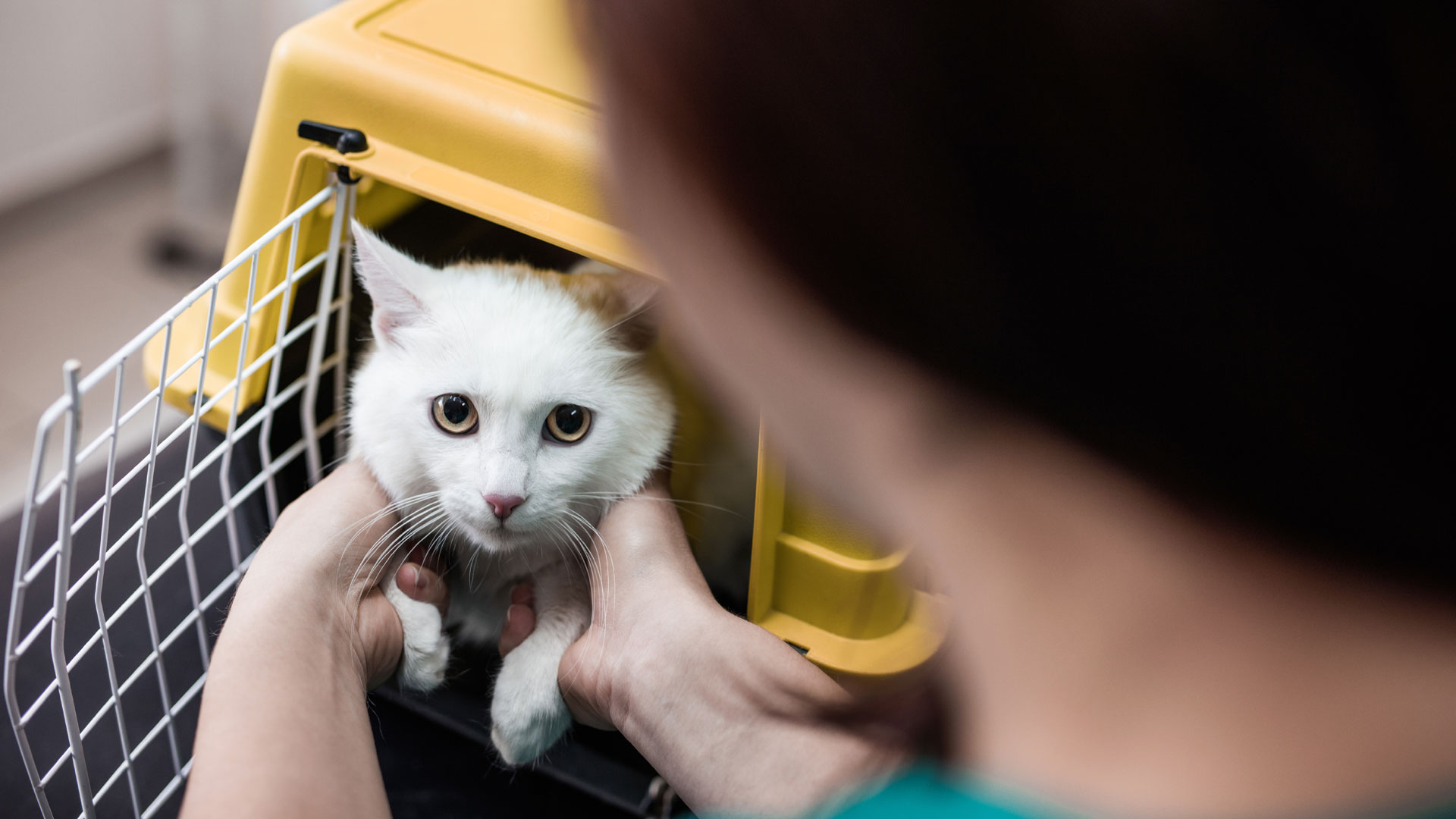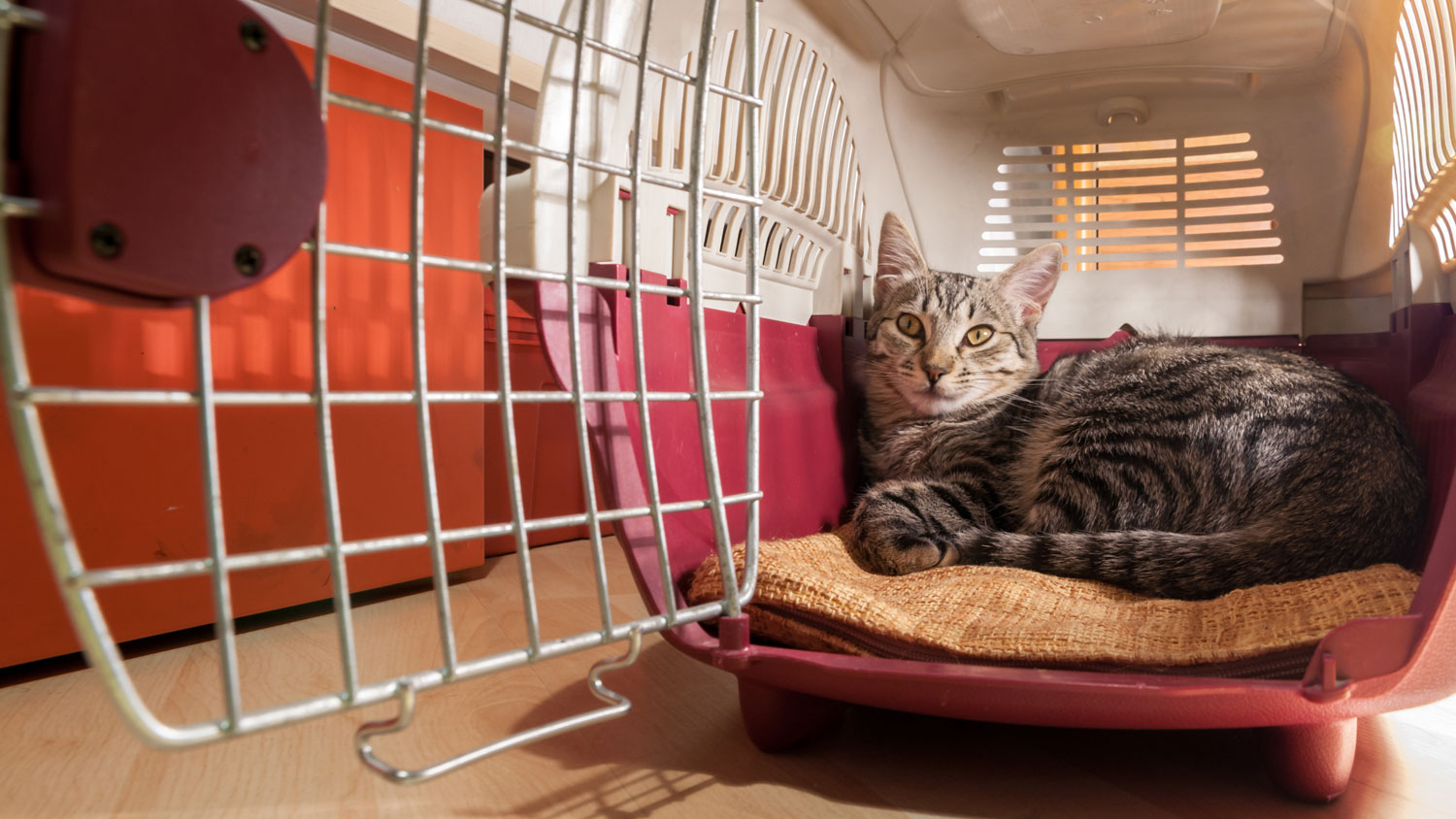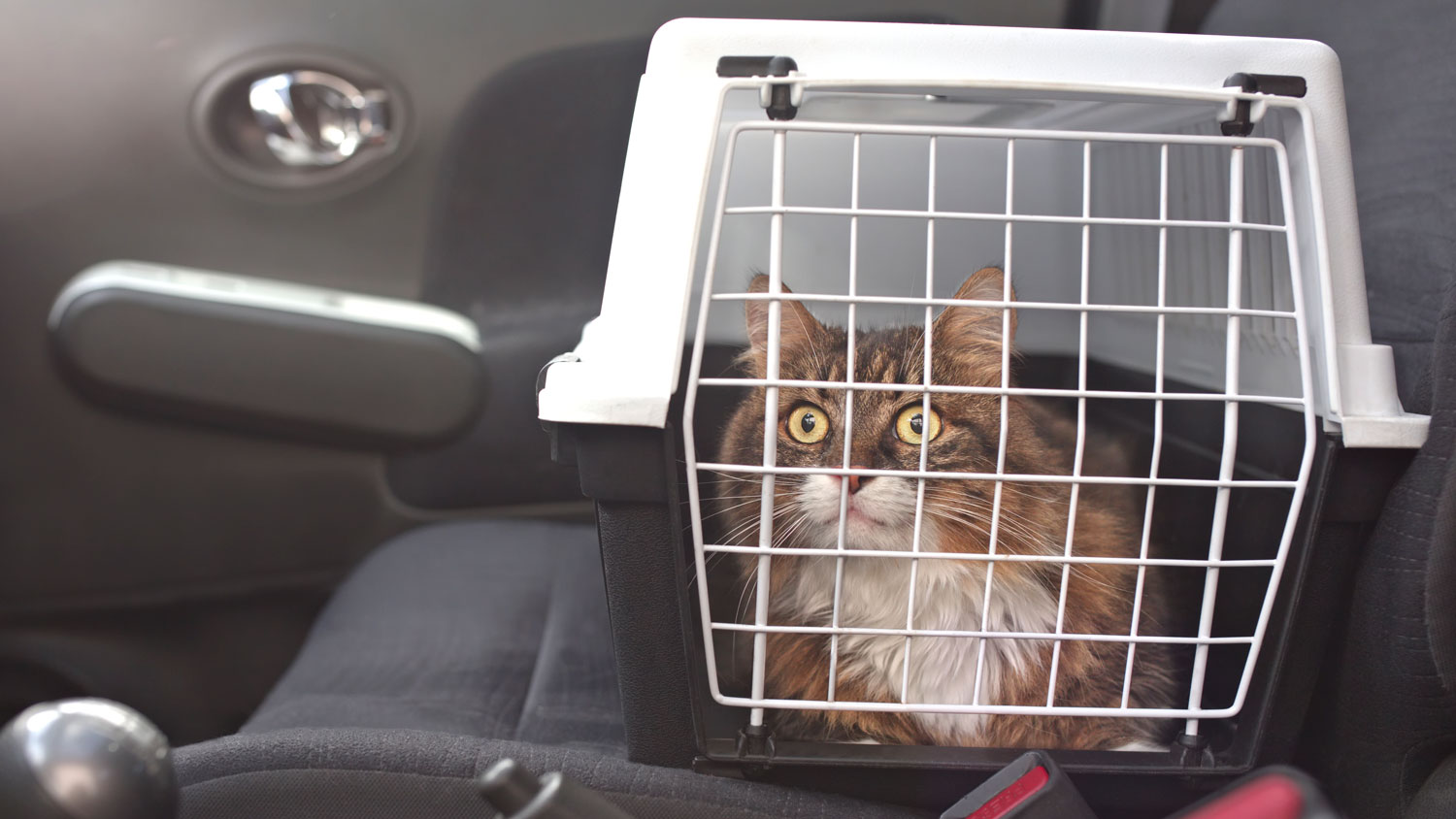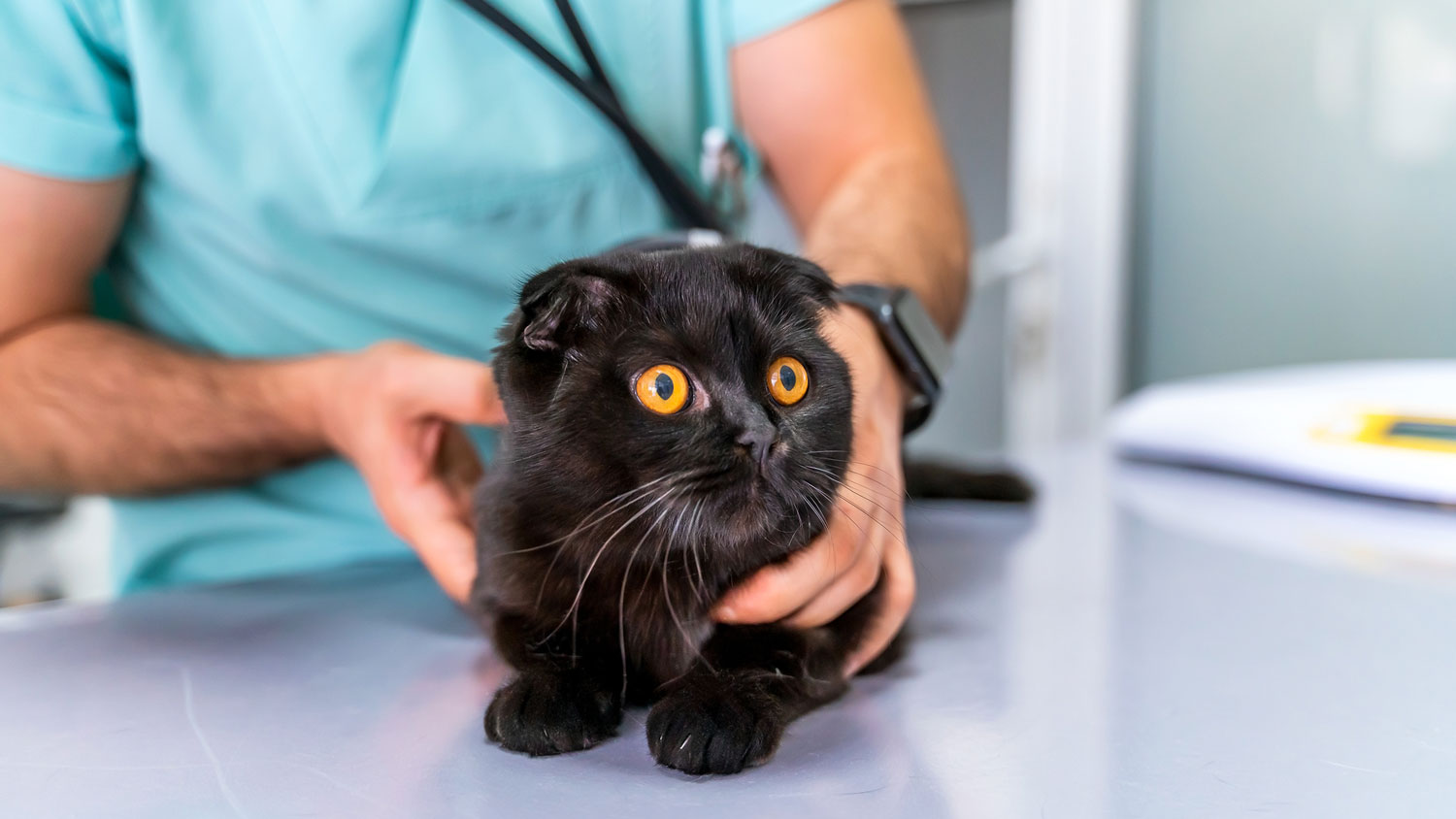How to get a scared cat to the vet
Wondering how to get a scared cat to the vet? We're here to make the whole situation less stressful for all involved

Figuring out how to get a scared cat to the vet can be one of the greatest challenges of cat ownership. You might have the sweetest-natured, purriest little floofball who's always up for cuddles and fuss, but you may yet discover that it transforms into a hissing, spitting whirlwind of teeth and claws when you need to pack it off to the vet for medical attention.
While some laidback moggies can take a trip to the vet in their stride, for many cats it's a perfect storm of bad things: getting stuffed in a box and then into a car, being taken into a waiting room with other nervous animals hanging around, then being hauled onto a table to be poked, prodded and even jabbed by a stranger, all while feeling poorly.
That's the sort of experience that can result in even the most chilled cat going into fight-or-flight mode at the first sign of a cat carrier being laid before them. For many owners too the mere prospect of getting a scared cat to the vet can make them put things off, perhaps until it's too late.
Don't do that. There are plenty of things you can do to make a vet visit less stressful for both your cat and yourself, from having the right cat carrier (especially if you're wondering how big should a cat carrier be) through to transporting your cat safely and helping it become less frightened of examinations.
Read on to discover how to make veterinary excursions at least flow more smoothly, even if they're not completely painless.
- Best cat treats: Spoil your kitty with a healthy snack
- Preparing for your kitten's first vet visit
- Soft vs hard cat carrier: which to choose?
Be prepared

Perhaps the hardest thing for a trip to the vets from a cat's point of view is the sudden interruption of its regular routine with a whole load of unfamiliar circumstances.
While cats are noted for their curiosity, having new stuff forced upon them isn't something they're quite so keen on. But by familiarizing your cat with the more stressful aspects of a vet visit in advance, you could help it become less scared when it comes to an actual appointment.
Get the best advice, tips and top tech for your beloved Pets
1. Create positive associations with the carrier
For your cat, the big warning sign that something terrible is about to happen is the appearance of the cat carrier. If you keep it tidied away most of the time, and only get it out when it's time for kitty to go to the vet or the cattery, your cat's only going to have strong negative associations with it.
So if you can, try leaving the carrier out all the time, and encouraging interaction; you could try putting meals in the carrier, or put some of your cat's favorite bedding in it.
Once they start to see the carrier as an unthreatening piece of furniture and maybe a place for a lovely nap, you'll have a much easier time getting them into it when necessary.
2. Get them used to being in the car
If you're taking your cat to the vet by car, that can be another scary experience. So again, try to make the car a less terrifying prospect. Give your cat the opportunity to explore the car if you can, or try putting it in there in its carrier to get used to the situation.
You could also try taking it for a little drive round the block, talking to it gently and calmly if it starts to get agitated, and then bringing it home so that it doesn't completely associate the car with going to horrible places.
3. Trial a mock examination
Another thing you can try to make the examination itself less frightening is to give your cat a mock examination at home.
By lifting it onto a table and getting it a little more used to some of the things a vet might do, such as examining its eyes, ears and teeth, and even using a toy stethoscope on its chest, you can begin to make the whole situation feel a little more normal for your cat. Be calm but firm, and remember to reward your cat with treats along the way.
Getting your cat into the carrier

If you've been leaving the carrier out to get your cat accustomed to it, you'll hopefully be in for an easier time when you need to get your cat into it. But obviously where cats are concerned there are no guarantees.
1. Choose the right carrier
One of the best ways to get a cat into a carrier is to have the right sort of carrier. Our guide to the best cat carriers will give you some useful tips, but the number one thing to look for is a carrier with a door in the top that you can lower your cat through, rather than trying to force it in through a front door.
However, if your carrier only has a door on the front, our guide to how to get a cat into a carrier can help you out.
2. Try standing the carrier on its end
From experience, the best trick to getting your cat into a carrier is to stand it on its end so that the door's on top, pick up your cat so that it's facing you and can't see where you're going with it, and lower it in feet-first, quickly clicking the door shut when it's safely in and then gently tilting the carrier back to horizontal.
How to transport your cat without a carrier

In an ideal world you'll have a cozy carrier ready to go when your cat needs it. But what if you don't have a carrier for some reason, or if your cat absolutely refuses to be shut in one?
Thankfully there are still options; you could try a cat harness, or perhaps try instead to get it into a less threatening cardboard box. You could even put it into a pillowcase, surprisingly enough; see our guide on how to transport a cat without a carrier for all the details on this and more.
Remember, though, that many vets only like cats to arrive in carriers, so if you're using an alternative form of transport you should definitely speak to the practice first and check whether they can deal with an unconfined feline.
Reducing stress at the vet

So, you've managed to actually get your cat to the vets. Congratulations! Now the fun really starts. As soon as you go in through the door your cat's likely to feel anxious because of the strange smells and noises and the presence of other pets in the waiting room. Here's how you can help them feel at ease:
1. Ask for alternative arrangements
It's possible to bypass all this by asking your vet if you can wait outside in the car and take your cat straight in when called; if that's not possible, though, see if the waiting room has a high-up platform specifically for cat carriers. A bit of height can help a nervous feline feel a lot more secure.
2. Seek a cat specialist
The examination itself can be less predictable because there's potentially a big unknown quality involved: the vet who's examining your cat. Some vets are better equipped to cope with difficult cats than others.
Some cats naturally have a strong aversion to being poked by strangers and their behavior can often hinge on how confidently a vet deals with them.
When booking your appointment for your cat, try to get a cat specialist. Even better, if your practice has a dedicated cat clinic, try to take it there. The vet will be much more attuned to your cat's needs and anxieties, the waiting room won't be full of excitable dogs, and the whole experience should feel a lot less threatening and traumatic for kitty.
By placing your cat in the hands of an experienced cat specialist, you're more likely to find that your scared cat only occasionally growls rather than kicks up a fuss!
3. Reward and praise
One final tip? Once the examination's over, reward your cat with praise and a treat. A little positive reinforcement at the right time can go a long way.
Getting a semi-feral or stray cat to the vet

This is all well and good for domestic cats, but what if you see a sick or injured semi-feral or stray cat and want to get it to a vet?
This can be tricky; a stray or semi-feral cat may look like a slightly grubby version of a house cat, but it's going to be a lot less amenable to being bundled into a carrier.
1. Call an expert
Unless you're absolutely certain of your ability to capture it without getting savaged, your best bet would be to call your vet or local animal shelter to see if they can send out an expert to trap it.
2. Use a blanket
Determined to try it yourself? There are options. If the cat's very unwell and clearly needs immediate attention, you might be able to trap it under a blanket, bundle it up and get it into a carrier.
3. Lure the cat
However if things don't look quite so serious, you can attempt to lure the cat into a carrier; you'll need a larger carrier, and it helps to cover it up so that it looks like an inviting nest for the cat to sleep in.
A food trail leading into the carrier can help entice it in, and scattering catnip inside can work too. Of course, you'll need to keep watch on the scene, but if the cat takes to the carrier and settles down in there you should have an easy time closing it up and heading for the vet.
Conclusion
Nobody ever said that getting a scared cat (or indeed a perfectly well-adjusted cat) to the vet was easy. But with preparation and understanding about just what can make a vet visit terrifying for your kitty, you can work out ways to hopefully make the experience a lot less of a trial for not just your cat, but yourself and the vet too.
Remember that a little pheromone spray can help calm an agitated feline, we have plenty more tips on how to cope with anxiety in cats. Good luck!
Want even more tips? Check out 20 ways to make a visit to the vet less stressful.
Jim is a writer, performer and cat-wrangler based in Bath, who last year adopted a pair of sibling rescue cats who turned out to be effectively feral, and has spent a lot of time since then trying to get them accustomed to people (some success) and each other (ongoing project).

